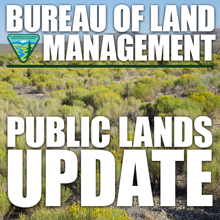
“At Interior, we are doing everything we can within the law to aggressively prepare for wildfire season,” said Deputy Secretary of the Interior Katharine MacGregor. “This proposed measure would significantly cut back on the time it takes to allow commercial timber operators into a landscape devastated by wildfire to remove marketable trees while also reducing or eliminating hazard trees that pose a danger to firefighters and infrastructure. Fostering timber jobs while reducing wildfire risks is a win-win.”
“We have to give our land managers the tools they need to reduce fuel loads and the threat of catastrophic wildfires in an environmentally sustainable manner. This proposal will allow us to increase the health and resilience of the landscape for both wildlife and people,” said William Perry Pendley, BLM Deputy Director for Policy and Programs.
The proposed CXs is part of a larger national wildfire reduction strategy guided by Executive Order 13855 – Promoting Active Management of America’s Forests, Rangelands, and Other Federal Lands to Improve Conditions and Reduce Wildfire Risk, as well as Secretary’s Order 3372 – Reducing Wildfire Risks on Department of the Interior Land through Active Management. The two orders direct Department of the Interior to implement policies to improve forest and rangeland management practices by reducing hazardous fuel loads, mitigating fire risk and ensuring the safety and stability of local communities through active management on forests and rangelands.
From 2000 to 2017, wildfires burned an average of 6.8 million acres annually in the U.S. For BLM-managed forests, fire has affected an average of 279,630 acres annually from 2009 to 2018. The threat of wildfires is accelerated by the presence of dead and dying timber. Insect and disease survey data collected in 2015 by the Forest Health Protection Program of the U.S. Forest Service identified 70 different mortality-causing insects and diseases across 5.2 million acres in the conterminous United States. The BLM assembled data from the U.S. Forest Service Aerial Detection Survey from 2008 to 2017 and found nearly two million acres of forest mortality were observed over that period on BLM lands.
Given the threat of wildfires across millions of acres of forests – and the threat this poses to native wildlife and the lives and livelihoods of people and communities across the West – the BLM has identified that establishing a new CX for the actions is necessary to expedite the removal of dead and dying timber to reduce fuel loads and the threat of catastrophic wildfires.
NEPA requires Federal agencies to consider the potential environmental consequences of their decisions before deciding whether and how to proceed. The appropriate use of CXs allows NEPA compliance, in the absence of extraordinary circumstances that merit further consideration, to be concluded without preparing either an environmental assessment or an environmental impact statement.
The proposal would affect only routine timber salvage projects smaller than 5,000 acres that normally do not require more extensive environmental analysis. While wildfire affects hundreds of thousands of acres of BLM-managed lands each year, current BLM regulations only allow for use of a salvage harvest CX that may not exceed 250 acres. This additional CX will increase the agency’s flexibility to respond to disturbances across larger areas.
The BLM has completed a review of scientific literature and previously analyzed and implemented actions and found no evidence that salvage harvest at the levels proposed would have a negative effect on forest health. To the contrary, removing dead and dying trees can accelerate forest succession and benefit native wildlife species that rely on successional habitat, while reducing the potential for catastrophic wildfires.
The BLM is opening a public comment period on the proposed CX that closes 30 days after the proposal publishes in the Federal Register. The BLM will provide additional information about when and how to comment when the proposed rule is published.
For more information on the BLM’s forest management activities, visit https://www.blm.gov/programs/natural-resources/forests-and-woodlands





